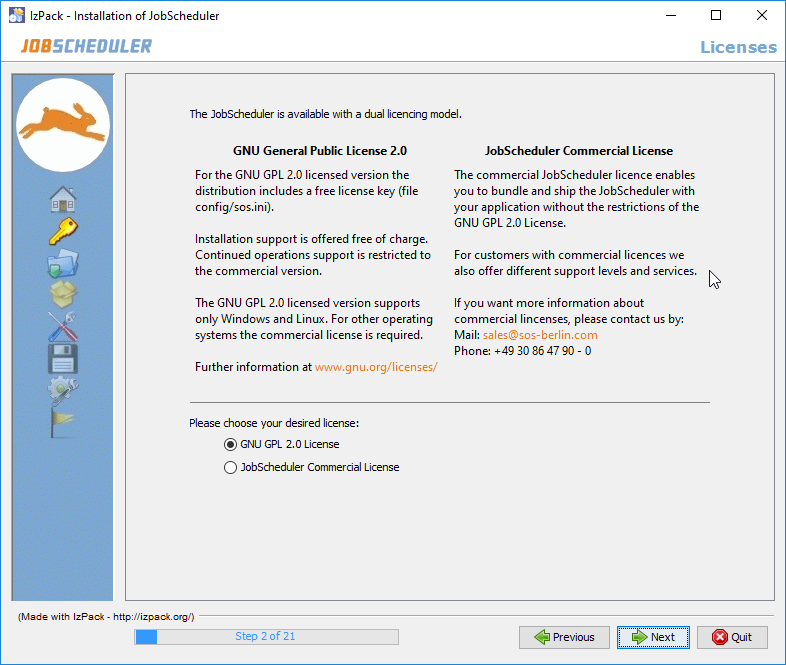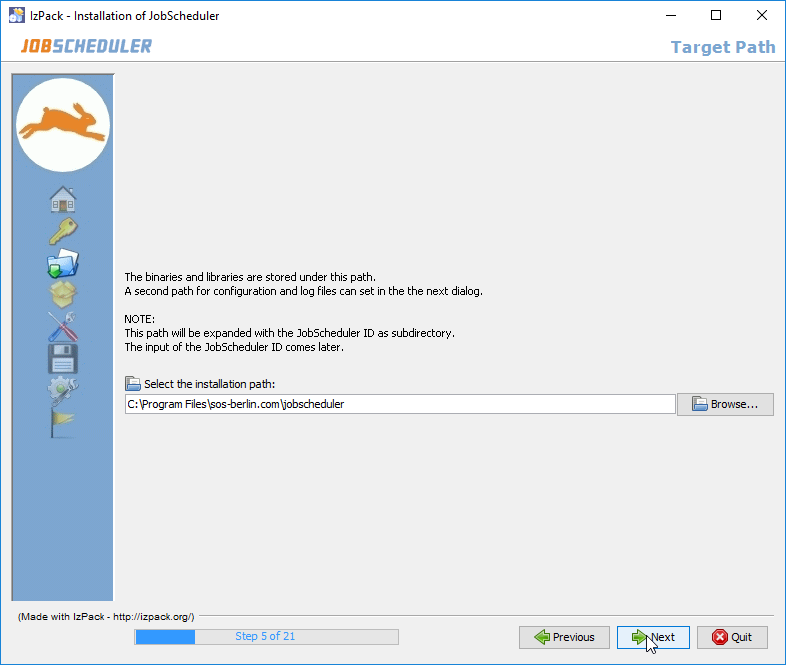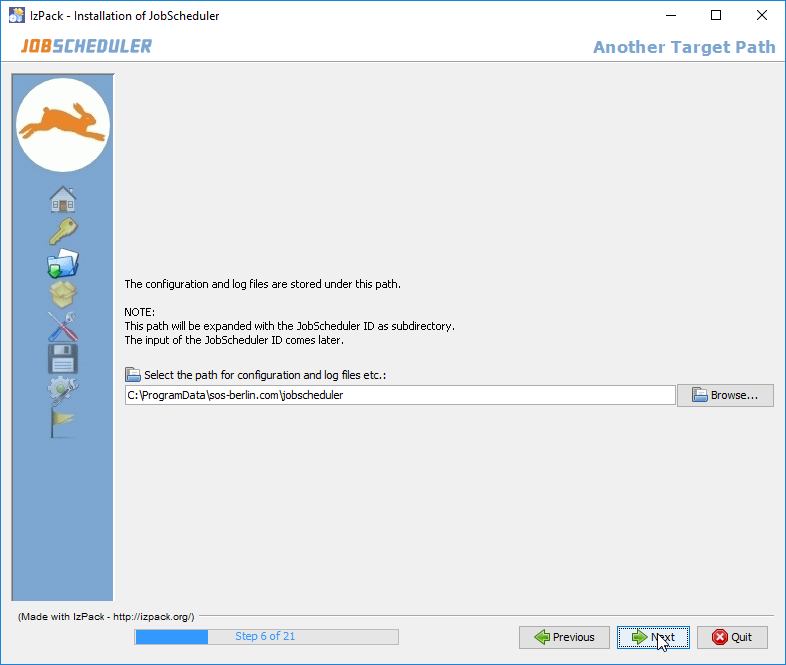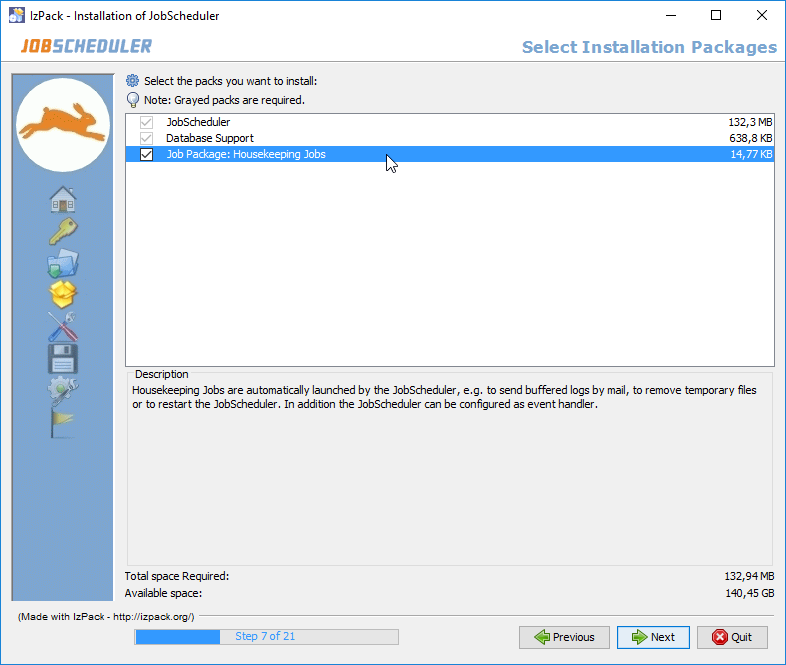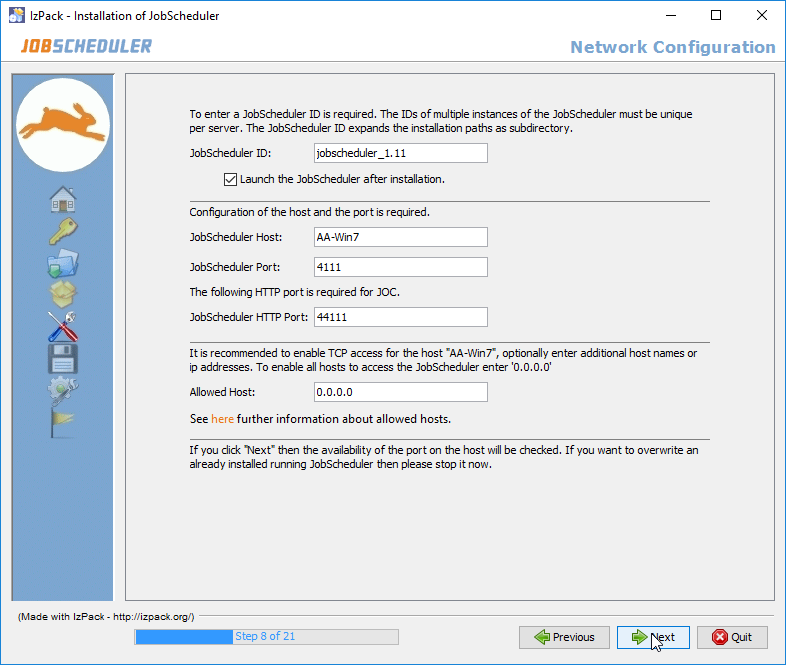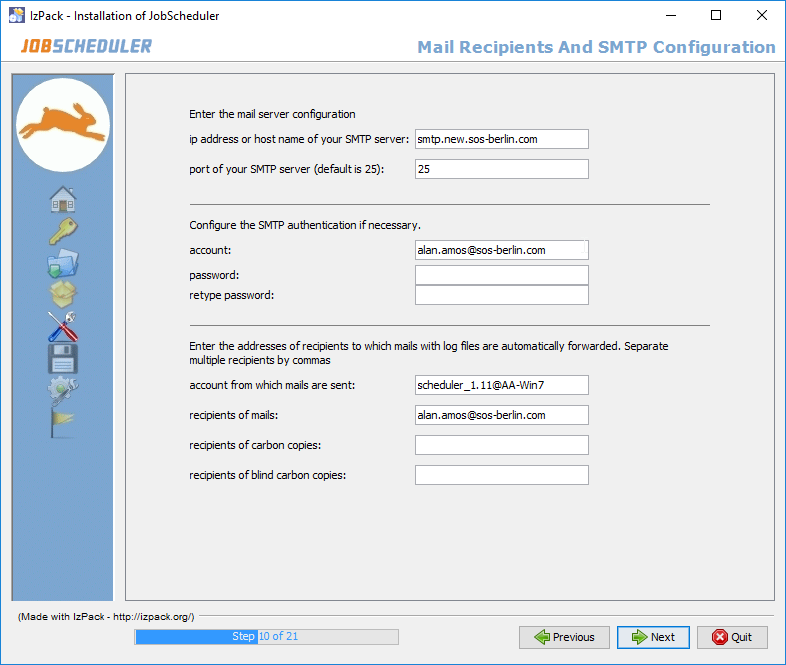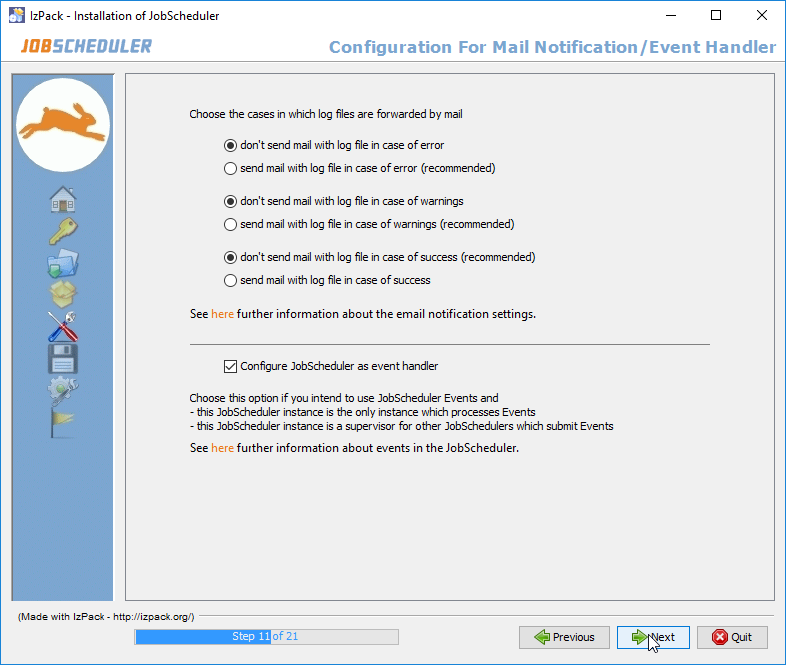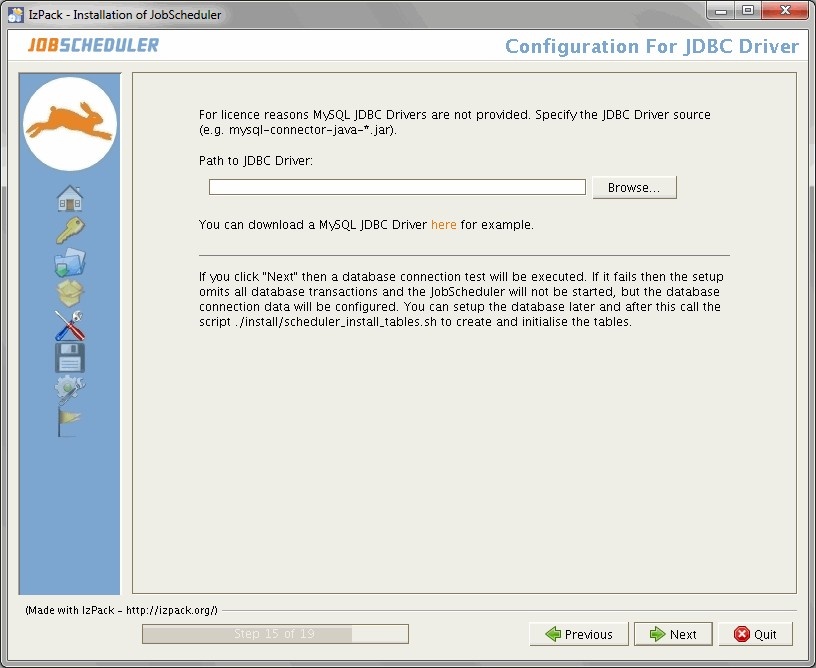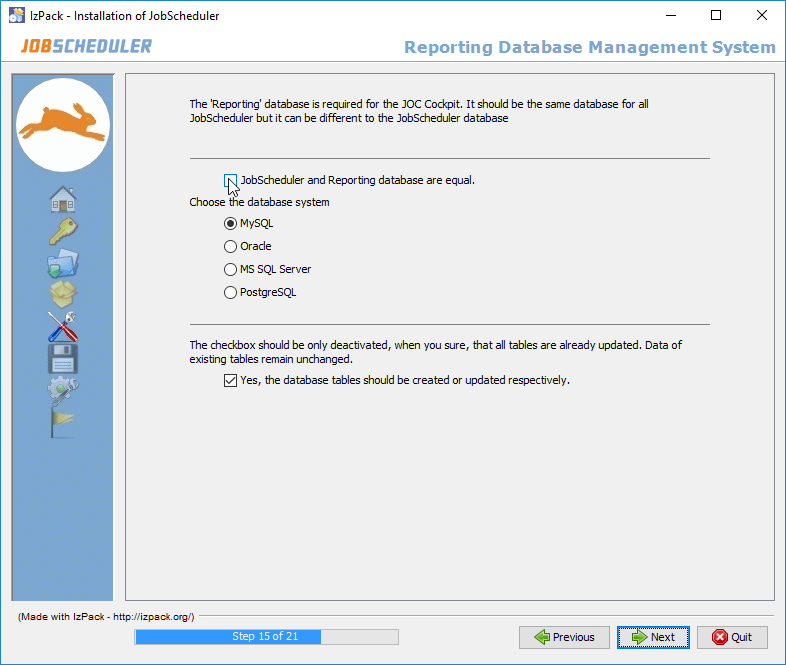| Table of Contents |
|---|
The steps described below should be carried out when making a new installation of the JobScheduler, in the order presented below:
- Database Configuration
- The JobScheduler requires a database except it will be used as an agent. The JobScheduler needs the database to archive logs and to remember Job and Order states. A JobScheduler agent doesn't have own Jobs or Orders and the logging is made by the JobScheduler which calls the Agent. So an Agent is running without a database.
- You find the supported database management systems listed in the Which Database Management Systems are supported by JobScheduler? article.
- Because of licensing restrictions when used with MySql®, Sybase or Microsoft® SQL Server databases, a JDBC® driver appropriate to the database version used must be provided by the end user themselves. Alternatively, a jTDS JDBC® driver, delivered with the JobScheduler setup, can be used for Microsoft® SQL Server and Sybase databases. Similarly, the MariaDB® driver is delivered with the JobScheduler setup, for use for MySql® Server and MariaDB® databases. For IBM® DB2 a JDBC® driver inlusive the license file must be provided by the end user too. Drivers for Oracle® Database and PostgreSQL are contained in the JobScheduler setup.
- JobScheduler Installation
- Installation of the JobScheduler is carried out using a setup program. This can be downloaded from the SOS Web-Site for Microsoft® Windows® and Linux®.
- For more information see the Which platforms is JobScheduler available for and what platform support is provided? article.
1.1 Requirements
The JobScheduler is for Linux® and Microsoft® Windows® in 64-bit and 32-bit available, for other operating systems currently still only in 32-bit.
Requirements for 32-Bit JobScheduler
- Oracle® Database Java® Runtime Environment (JRE) 32-Bit at least version 1.8.x. For IBM®AIX® you can use the IBM® Java 32-Bit at least version 1.8.x, too.
- For Unix®:
- linux-gate.so.1
- libz.so.1
- libpthread.so.0
- libdl.so.2
- libm.so.6
- ld-linux.so.2
Two components (JobScheduler Object Editor (JOE) and JobScheduler Information Dashboard (JID)) of the JobScheduler are SWT applications which requires an X-windows system and GTK2.The installation includes a 32-Bit swt.jar, so you need the 32-Bit libraries:
- libgtk-x11-2.0.so.0
- libXtst.so.6
- For Microsoft® Windows®:
- The library msvcr100.dll must be stored in C:\windows\system32 and also in C:\windows\SysWOW64 on 64-Bit Microsoft® Windows®.
- You find the msvcr100.dll in the Java installation [Java® Runtime Environment (JRE) install path]\bin.
If you use "Remote Configuration" then the Workload JobSchedulers and its Supervisor JobScheduler should have the same version. Further information about "Remote Configuration" can be found in the Which components will be installed on a client and how will jobs be started there? article..
Requirements for 64-Bit JobScheduler
- Oracle® Database Java® Runtime Environment (JRE) 64-Bit at least version 1.8.x. For IBM®AIX® you can use the IBM® Java 64-Bit at least version 1.8.x, too. For Unix®:
- A shell in /bin/sh (or a symlink)
The JobScheduler requires some 64-Bit libraries.These are on Linux®:
- linux-vdso.so.1
- libz.so.1
- libpthread.so.0
- libdl.so.2
- libm.so.6
- libc.so.6
- ld-linux-x86-64.so.2
Two components (JobScheduler Object Editor (JOE) and JobScheduler Information Dashboard (JID)) of the JobScheduler are SWT applications which requires an X-window system and GTK2. The installation includes a 64-Bit swt.jar, so you need the 64-Bit libraries:
- libgtk-x11-2.0.so.0
- libXtst.so.6
...
| Info | ||
|---|---|---|
| ||
Follow the steps described in the following parts of this installation guide before starting to install the JobScheduler Master: |
| Anchor | ||||
|---|---|---|---|---|
|
...
Installation Using the Setup Program
The following archive files including installer are available from the SOS Web-Site and from Source Forge:
jobscheduler_linux-x64.[release].tar.gzfor Linux®gzfor Linux 64-Bitjobscheduler_linux-x86.[release].tar.gzfor Linux®gzfor Linux 32-Bitjobscheduler_windows-x64.[release].zipfor Microsoft® Windows®zipfor Microsoft Windows 64-Bitjobscheduler_windows-x86.[release].zipfor Microsoft® Windows®zipfor Microsoft Windows 32-Bit
Where [release] is the JobScheduler version number.
Unpack the archive in into an arbitrary directory and change to the extracted directory ./jobscheduler.[release].
The installer can be started as a dialog or in batch mode (see Batch Installation). If you use the installer as a dialog on Unix® then it requires Unix then you will require an X-Server. If Use Batch Installation if an X-Server is not installed, then use Batch Installation.available.
To start the installer enter the following in a terminal window:
| Code Block | ||||
|---|---|---|---|---|
| ||||
/tmp/jobscheduler.[release]> ./setup.sh |
...
The setup requires administrator privileges on Microsoft® Windows®Microsoft Windows. The setup opens will open a dialog for this on Microsoft® Windows® Windows if necessary. On Unix® Unix a sudo prompt will be open. Don't log in as root on Unix® Unix but use sudo! .
Under Unix®Unix, the root privileges are not required. If you want to install the JobScheduler without root privileges, then call:
| Code Block | ||||
|---|---|---|---|---|
| ||||
/tmp/jobscheduler.[release]> ./setup.sh -u |
Procedure Overview
The setup dialog starts with the selection of the language to be used in the setup. This is followed by a greeting, acceptance of the license conditions and the specification of the two installation directories that are required. The binaries and libraries are stored under the first pathdirectory.The configuration and log files are stored under the second path.
For the rest of this documentation installation guide the first installation directory will be referred to as $SCHEDULER_HOME and the second as $SCHEDULER_DATA.
Specification of the installation directories is followed by the Package Selection dialog. The forms which are subsequently presented for the configuration of the JobScheduler depend on the packages which are selected for installation alongside the JobScheduler. Further details of the JobScheduler configuration are to be found in the Setup Forms section.
After selection of the required packages, the necessary files are copied into the installation directories. After this, the scripts that configure the installation packages are executed. The processing of the installation scripts run during the setup is logged. This log file is to be found in the folder $SCHEDULER_DATA/logs and is named Install_V[release]_[date][time]_[series number].log.
The JobScheduler Operations Center (JOC) interface can be accessed after the setup by entering the following URL in a web browser (Firefox , Microsoft® Internet ExplorerMicrosoft Edge®, Chrome® are supported):
http://localhost:[port]where[port]is the port specified for the JobScheduler instance during setup.
...
The JOC Cockpit interface has to be installed separately to the JobScheduler. After both have been installed the JobScheduler can be accessed after the setup by entering the following URL in a web browser (Firefox , Microsoft Edge® & Internet Explorer®, Chrome® are supported):
http://localhost:[port]/joc/where[port]is the HTTP/HTTPS port specified for the JobScheduler instance during setup.
| Anchor | ||||
|---|---|---|---|---|
|
Licenses
The JobScheduler is available with a dual licensing model. The : the GNU GPL 2.0 license and a commercial license is are available for Microsoft® Windows® and Linux®, otherwise the commercial license is requiredMicrosoft Windows and Linux.
If you choose the commercial license then an input field is shown to enter the license key. The license key will be written in the file $SCHEDULER_DATA/config/sos.ini. Even so If you have problems with the license key is invalid you can continue with the installation and edit the $SCHEDULER_DATA/config/sos.ini later.
...
| Anchor | ||||
|---|---|---|---|---|
|
Installation Paths
The setup knows two paths. Both paths are expanded requires the paths to two directories. A sub-directory named with the JobScheduler ID as subdirectory. The form to enter the will then be added to both these directories later in the installation procedure. The JobScheduler ID will be described entered later on.
Step 5: The Installation Path
The binaries and libraries are stored in this first path (directory, which will be referred to as $SCHEDULER_HOME) in the rest of this installation guide. The default ispaths to this directory are:
/opt/sos-berlin.com/jobschedulerfor Unix®Unix®. If you use the installer without root permissions then you must choose another folder (e.g./home/[user]/sos-berlin.com/jobscheduler).C:\Program Files\sos-berlin.com\jobschedulerfor Microsoft® Windows®
...
- Microsoft® Windows®
Step 6: The Configuration and Log File Path
The configuration and log files are stored in this second path ($SCHEDULER_DATA)directory, which will be referred to as $SCHEDULER_DATA in the rest of this installation guide. The default ispaths to this directory are:
/home/[user]/sos-berlin.com/jobschedulerfor Unix®UnixC:\ProgramData\sos-berlin.com\jobschedulerfor Microsoft® Windows® Vista/2008/7C:\Documents and Settings\All Users\Application Data\sos-berlin.com\jobschedulerfor Microsoft® Windows® XP/2003- Microsoft Windows
| Anchor | ||||
|---|---|---|---|---|
|
...
Setup Packages
The following packages may be selected during setup:
- JobScheduler
- This is the basic package and must be installed. The package contains JobScheduler Operations Center (JOC) which is an Ajax based interface for monitoring and controlling the JobScheduler objects, such as Jobs, Job Chains and Orders. Further the package contains JobScheduler Object Editor (JOE) to create, edit and maintain the JobScheduler objects and JobScheduler Information Dashboard (JID), which provides an overview of the jobs planned and those that have successfully been completed.
- Database Support
- This package allows the job protocols to be stored in a database. MySql® (5.x ++), Oracle® Database (8.1.x, 9.2, 10g, 11g), Microsoft® SQL Server (2000, 2005, 2012), PostgreSQL (8.x, 9.x), IBM® DB2 (8.x ++) und SybaseASE 15.0. are supportedmust also be installed. The DBMSs supported are listed in the Which Database Management Systems are supported by JobScheduler? article.
- Housekeeping Jobs
- Housekeeping Jobs are automatically carried out by the JobScheduler, for example, resending re-sending temporarily stored protocol mails after a mail server failure; deleting temporary files or restarting the JobScheduler automatically. In addition, the Housekeeping Jobs package enables the JobScheduler to be configured as an event handler.
Package selection is made using the following dialog form:
| Anchor | ||||
|---|---|---|---|---|
|
...
Setup Forms
The number of forms shown during setup depends on the packages which have been chosen for installation and on the database configuration.
1.6.1 The Basic JobScheduler Forms
...
Network Configuration
The JobScheduler ID
- The JobScheduler ID is entered in the JobScheduler ID input box.
...
- Avoid special characters
...
- such as / \ : ; * ? ! $ % & " < > ( ) | ^
- The ID is used on
...
- Microsoft Windows as the name of the
...
- JobScheduler service after setup. The service name
...
- will have the syntax
sos_scheduler_[scheduler_id]. - The JobScheduler ID must be unique over all installed
- will have the syntax
...
- JobSchedulers. (Unless you are building a cluster, in which case all JobScheduler Masters have the same ID. See JobScheduler Master Installation - 10 - Cluster Installation for more information.)
- In addition, the JobScheduler ID
...
- is used as a subdirectory
...
- name in the both the
$SCHEDULER_HOMEand$SCHEDULER_DATAinstallation paths. - The JobScheduler ID is written to the
$SCHEDULER_HOME/bin/jobscheduler_environment_variables.(cmd|sh)file and can be changed manually later on.
- name in the both the
The JobScheduler Ports
- The JobScheduler Port is used for TCP communication with the JobScheduler.
- The JobScheduler HTTP Port is used for HTTP communication by the JobScheduler Web Services
...
- e.g. for JOC Cockpit.
...
You can call JOC with Jetty. Jetty needs a unique port for HTTP and HTTPS. See also the How to operate JobScheduler with Jetty article for more details about Jetty.
...
-
This port must be unique for each JobScheduler Master being operated either standalone or as a cluster member.
- The Port entries are written to the
$SCHEDULER_DATA/config/scheduler.xmlfile and can be changed manually later on.
-
The Allowed Host
- This field is required as a security feature of the JobScheduler, whereby communication can be restricted to particular computers. This feature is explained in more detail in the JobScheduler
allowed_hostdocumentation. - The
- This field is required as a security feature of the JobScheduler, whereby communication can be restricted to particular computers. This feature is explained in more detail in the JobScheduler
...
- Allowed Host
...
- entry is also written to the
$SCHEDULER_DATA/config/scheduler.xml
- entry is also written to the
...
The JobScheduler ID is written to the $SCHEDULER_HOME/bin/jobscheduler_environment_variables.(cmd|sh) file.
...
- file and can be changed manually later on.
Mail and SMTP Configuration
The SMTP Server is specified here in this form, along the mail sender, recipient and if required CC und and BCC recipients if required. Multiple addresses are to possible and should be separated by commas.
The values entered here configure Values entered in this form are saved in the $SCHEDULER_DATA/config/factory.ini file, which can also be changed manually later on.
Mail Notification & Event Handling
This form is used to specify the conditions under which Specify information regarding whether the JobScheduler should automatically forward job log files by e-mail.
The entries made using this form are saved in the $SCHEDULER_DATA/config/factory.ini file, which can also be changed manually later on.
The lower part of this form is only shown when the housekeeping package was selected. It enables the JobScheduler Housekeeping Package was selected in the Setup Packages form and is used to specify whether the JobScheduler is to be configured as an event handler. Corresponding Relevant objects will be created in $SCHEDULER_DATA /config/live/sos/events respectively folder. This is explained in more detail in the Events documentation.
1.6.2 The Database Support Package Forms
The following forms are only shown when the Database Support package was selected.
Note that the JobScheduler can alternatively be integrated with a system monitor that can be used to send notifications - see the Monitoring article for more information.
| Anchor | ||||
|---|---|---|---|---|
|
The JobScheduler Database Configuration Forms
Standalone / Cluster Configuration
The radio buttons in the form shown above determine whether the architecture in which the JobScheduler should Master is to be installed. The following options are available:
- "stand-alone"
...
- as part of a backup system , as primary or secondary JobScheduler, or
- as part of a load-balancing cluster.
See also JobScheduler Master Installation - (see also 10 - Cluster Installation of a Cluster.
. Further information about Backup Cluster can be found here, about Load Balancing look here. You can change the cluster option architecture later (see here).
The JobScheduler Database Management System
The database system is specified in the upper selection on this form. It is recommended that the box in the center of the form is remains checked, so that a the script which creates and fills the necessary database tables can be executed. Alternatively, the database tables can be be changed manually later on (page 28). If you have already installed another JobScheduler with the same database connection then abandon this option.
...
on.
The JobScheduler Database Connection
The access parameters for the JobScheduler database are specified in the upper part of this form. The database connection configuration is saved in three locations:
$SCHEDULER_DATA/config/factory.ini
...
$SCHEDULER_DATA/config/hibernate.cfg.xml
...
- and
$SCHEDULER_DATA/config/sos_settings.ini
...
- files.
All files can be be changed manually if required.
Configuring the JDBC Driver-URL for Oracle RAC databases
The JDBC driver URL for Oracle RAC databases should be entered in the Host field of the database connection form. For example:
Code Block jdbc:oracle:thin:@(DESCRIPTION=(ADDRESS_LIST=(LOAD_BALANCE=OFF)(FAILOVER=ON) (ADDRESS=(PROTOCOL=TCP)(HOST=tst-db1.myco.com)(PORT=1604)) (ADDRESS=(PROTOCOL=TCP)(HOST=tst-db2.myco.com)(PORT=1604))) (CONNECT_DATA=(SERVICE_NAME=mydb1.myco.com)(SERVER=DEDICATED)))
In addition the Schema and Port fields should be left empty.
The JDBC Driver
The JDBC driver to be used is specified in the middle part of the form:
- The jTDS JDBC
®driver delivered with the JobScheduler is only shown as an option when Sybase® or Microsoft SQL Server® DBMSs have been specified. - If you have specified a MySql® DBMS then you will get a checkbox for specifying whether you want to use the MariaDB® JDBC® driver provided with the JobScheduler.
- If you do not check the jTDS JDBC® or the MariaDB JDBC drivers then you must enter your own JDBC® driver in the form shown below.
This dialog form is offer offered for:
- ... IBM® IBM® DB2.
- ... MySql® and you have unchecked the MariaDB® JDBC® driver for MySql® databasesMySql® when Use the MariaDB® JDBC® driver for MySql® databases was not checked.
- ... Microsoft® Microsoft® SQL Server or Sybase and you have unchecked when Use the jTDS JDBC® JDBC® driver for Sybase and Microsoft® Microsoft® SQL Server databases was not checked.
- ... Oracle® when Existing Oracle® JDBC® should be used was not checked.
The script for the creation of the database tables is started by the setup program and requires a
...
JDBC® driver appropriate to the database system being used.
...
See the Overview and Requirements part of this installation guide for information about the database driver required by the JobScheduler Master. The driver for PostgreSQL and an Oracle ojdbc6 driver are included in the setup. However, the relevant
...
IBM® DB2, MySql®, Sybase
...
, Microsoft® SQL Server
...
and an Oracle® ojdbc7 JDBC® driver must be manually specified here. Note that for
...
Microsoft® SQL Server and Sybase databases the jTDS
...
JDBC® driver and for
...
MySql® the MariaDB® JDBC® driver that is delivered as part of the JobScheduler setup can be used when the appropriate checkbox in the previous form
...
was activated.
Note that for IBM® For IBM® DB2 you have to provide a license file for the driver too. As this driver will also be required by the JobScheduler later on, it is copied by the setup into the $SCHEDULER_HOME /lib/user_lib folder.
The Reporting Database Configuration Forms
Reporting information can be stored in the same database as used by the JobScheduler Master, which was configured in the steps described above, or in a separate database, possibly using another DBMS.
Unchecking the JobScheduler and Reporting Databases are the same box in the form shown below will allow the fields for configuring a separate reporting database to be shown.
If a separate reporting database is to be used then a second form for the Reporting database will be shown in which the database connection for the Reporting Database will be specified. The configuration information entered in this step is identical to that already specified for the JobScheduler Database Connection and need not be repeated here. (See above.)

